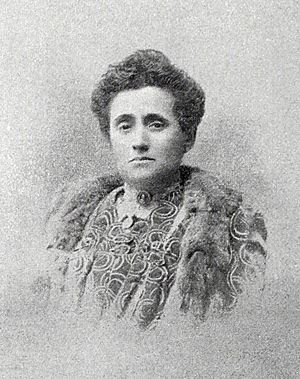Concepción Aleixandre facts for kids
Quick facts for kids
Concepción Aleixandre
|
|
|---|---|
 |
|
| Born |
María de la Concepcion Aleixandre Ballester
2 February 1862 |
| Died | 1952 Valencia, Spain
|
| Nationality | Spanish |
| Occupation | Doctor Inventor Scientist Educator |
María de la Concepcion Aleixandre Ballester (1862 – 1952) was a Spanish teacher, doctor, and inventor. She was also a scientist and writer. Concepción was a very important person because she was the first woman ever allowed to join Spain's Gynecological Society. A gynecologist is a doctor who specializes in women's health.
Life and Education
Concepción was born in 1862 in Valencia, Spain. Her family was quite wealthy. After finishing high school, she went to a special school for girls in Valencia. There, she earned a teaching degree. Even though she never became a teacher, she always loved learning and teaching others.
Concepción decided to do something very unusual for women at that time. Most women were expected to stay home and take care of their families. But Concepción wanted to be a doctor! She enrolled in the Faculty of Medicine at the University of Valencia. This was a big challenge because very few women studied medicine back then. She faced many difficulties with the university leaders, but they finally let her join.
Becoming a Doctor
At the university, Concepción studied alongside another pioneering woman, Manuela Solís Clarás. Both of them graduated in 1889 with excellent grades. Concepción was one of the first women in Spain to earn a university degree. She specialized in gynecology, which is the study of women's reproductive health. She then went to Madrid to complete her doctorate.
Concepción worked as a doctor at several hospitals. She was an assistant doctor at the Hospital de la Princesa starting in 1891. Later, in 1902, she worked at the Provincial House of Maternity. She also opened her own private clinic. At first, she treated poor women for free at her home. Later, she opened clinics in different parts of Madrid. She made sure her clinics had flexible hours and prices so that people from all backgrounds could get help. She was known for being very kind and caring with her patients and their children.
Her Invention
In 1910, Concepción Aleixandre invented something important. She got a patent for two special metal devices called pessaries. These devices helped support a woman's internal organs. They were designed to help with certain health issues without needing surgery.
Concepción's invention was based on her own experiences as a doctor. Her device was made of aluminum with steel springs. It came in two different models to fit different needs. She even included drawings to show how to use them. The devices were also easy to clean. Although her patent expired in 1912, it's likely she used her invention in her daily work to help her patients.
Advocacy and Recognition
Concepción was also very active in groups that worked for women's rights. She believed strongly that women should have more opportunities. She wrote many articles for journals and gave speeches at scientific meetings.
In 2001, Concepción Aleixandre was recognized as one of the "100 women of the twentieth century who paved the way for equality in the 21st century women." This shows how important her work was in helping women gain more rights and opportunities.
See also
 In Spanish: Concepción Aleixandre para niños
In Spanish: Concepción Aleixandre para niños

